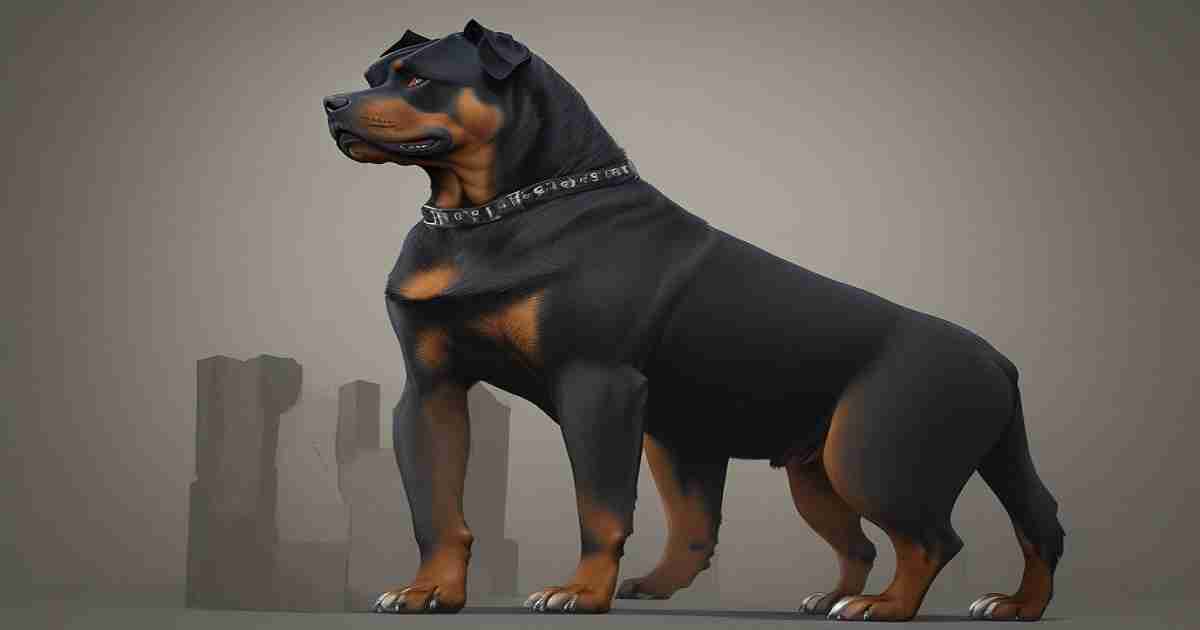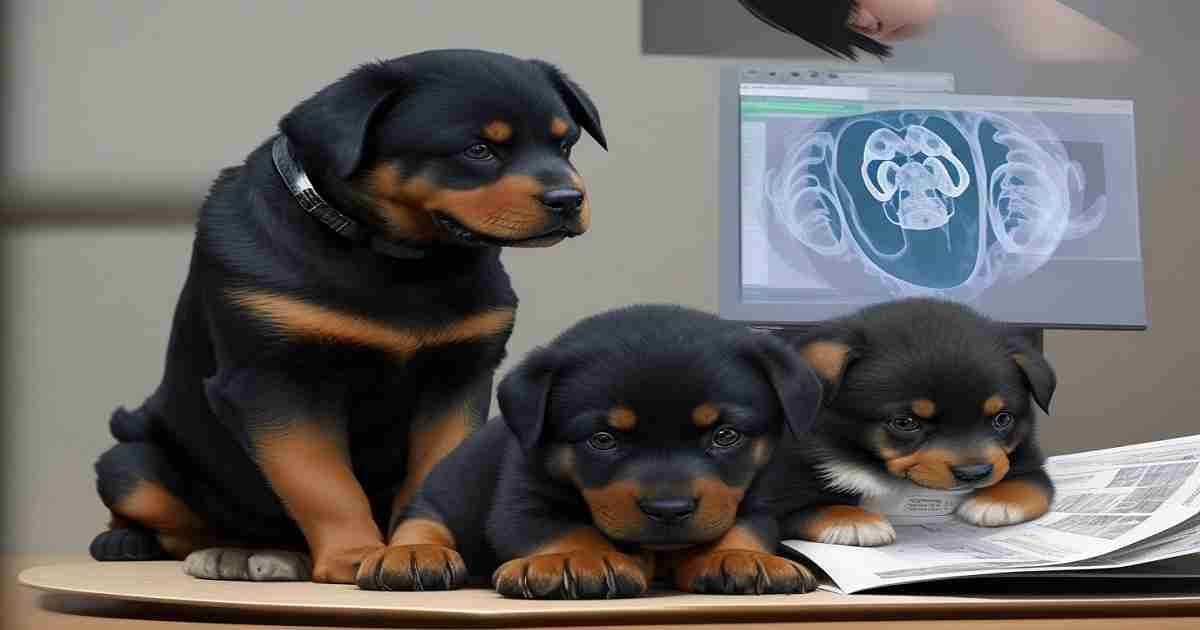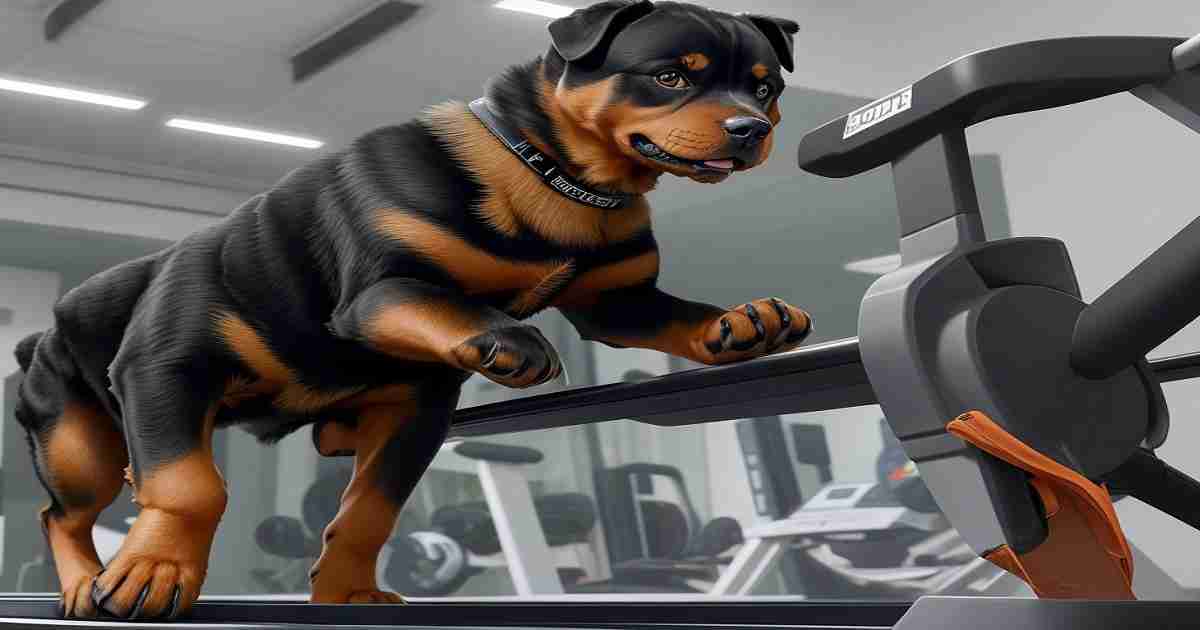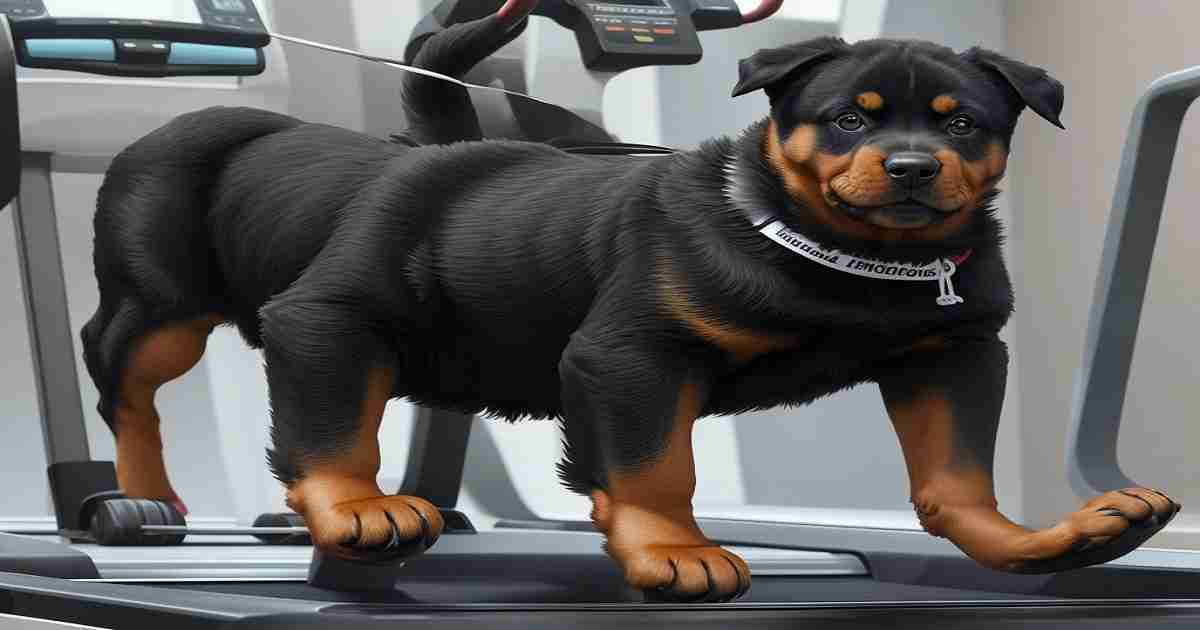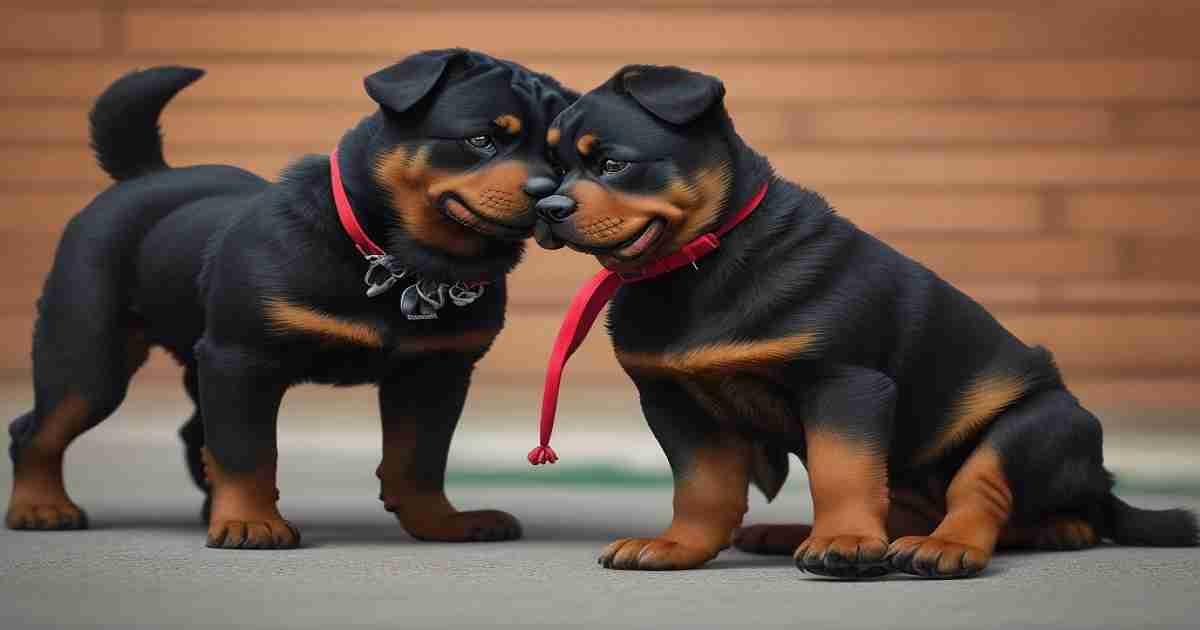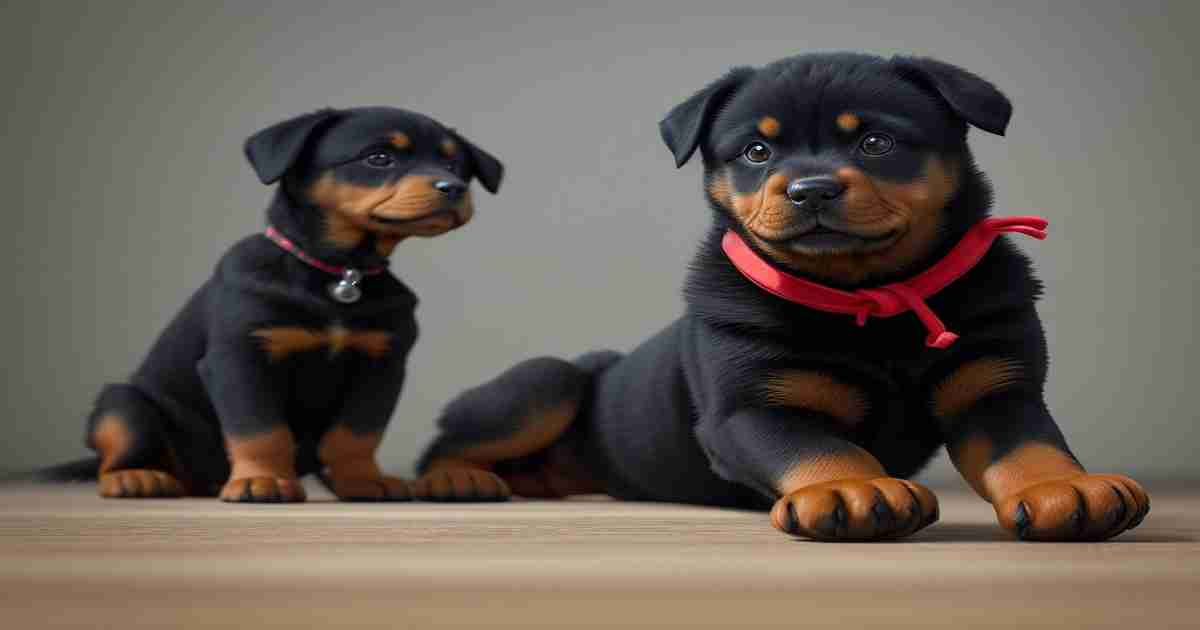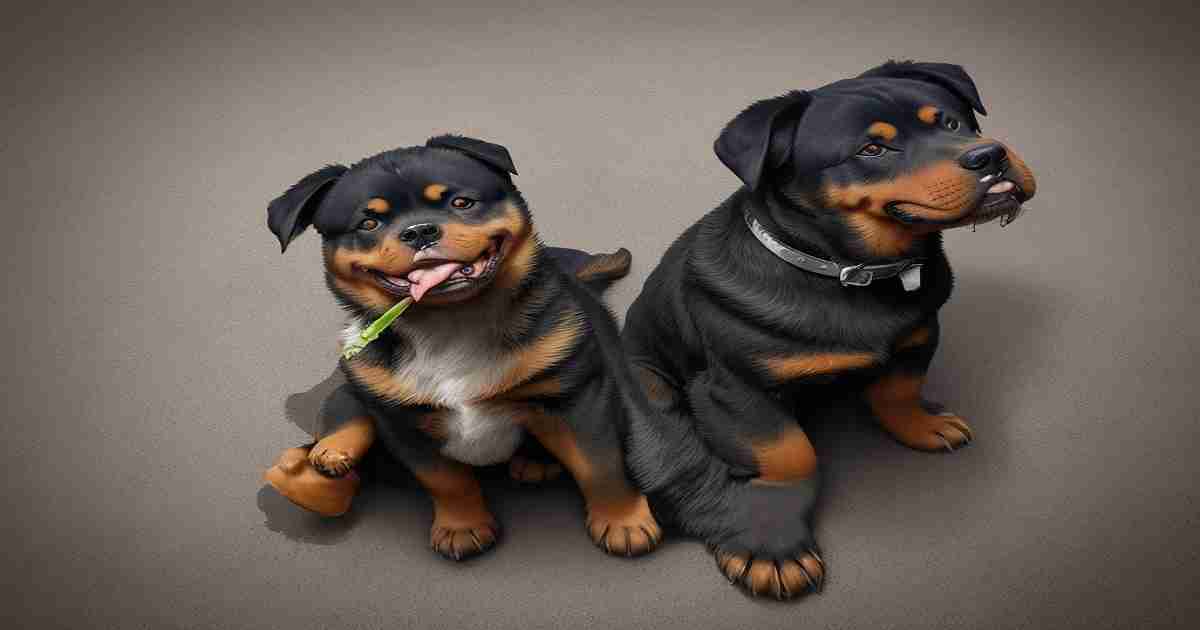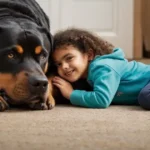So you want a Rottweiler with a big, blocky head? I feel you. That impressive head is part of what makes Rotties so regal and intimidating.
But getting your pup’s head to reach its maximum size and proportions takes some work. As a long-time Rottweiler owner and certified dog trainer, I’ve picked up plenty of tips for maximizing head size through the years. In this post, I’ll share everything I’ve learned to help you achieve head-size goals for your Rotty.
An Overview of Techniques for Increasing Head Size
While genetics determine the upper limits for your Rottweiler’s head size, there are things you, as an owner, can do to help them reach their full potential. Here are some of the main strategies I’ll cover in this guide:
- Picking the right puppy: Evaluating structure, pedigree, and parents’ head sizes sets the stage for success.
- Nutrition: Providing proper nutrition supports bone growth and muscle development.
- Exercise: Specific exercises build up muscles to give that blocky, powerful look.
- Training: Engaging their mind and jaws strengthens the skull.
- Medical options: Surgeries or supplements if genetics pose limits.
But before diving in, it’s essential to manage expectations. While these techniques can help increase head size, there are no guarantees your Rotty will have the giant, GSD-sized head you might envision. Genetics plays a huge role. Now, let’s look at each strategy more closely.
Role of Genetics in Determining Maximum Head Size
The size and proportions of your Rottweiler’s head are determined mainly by their genes. Responsible breeders aim to produce puppies from dogs with the desired skull structure in their lineage.
However, even pups from champion bloodlines can vary. Like people, not all siblings will be born with the same bone structure. Gender also plays a role. Males typically have more prominent, blockier heads than females.
The Rottweiler skull is one of the breed’s most distinctive features. It is described as medium length, broad between the ears, with a pronounced stop. The powerful jaws and full cheeks contribute to the desired short, wide, and massive appearance of the Rottweiler head.
Understanding how genetics influence head size can help set realistic goals. While you may be able to increase your pup’s head size through diet, exercise, and training, there is a natural maximum size and shape for each dog.
Some key genetic factors include:
- Head shape: Blocky vs. more slender, wedge-shaped.
- Stop: Pronounced vs. smooth transition from muzzle to skull.
- Cheekbones: Prominent vs. less defined.
- Muzzle: Square and broad vs. narrow.
- Eyes: Round and deep set vs. almond-shaped.
Suppose a dog’s parents and relatives have smaller or more wedge-shaped heads. In that case, your Rotty will likely have genetic limits on achieving a huge, blocky head.
Can I Increase Head Size After Puppyhood?
Many owners wonder – once my Rottweiler is grown, can I still make their head bigger?
The maximum growth of your dog’s skull occurs early in life. After that point, you cannot significantly alter size or shape.
According to Rottweiler breeder James Darkson of Von Barren Kennels:
By 12-18 months old, skull growth is complete. At this point, it is impossible to increase the length or width. Owners can build muscle through training, but the underlying bone structure is set.
So, focus on diet, exercise, and training while your Rottweiler is still a puppy. Their youth is the critical window for influencing head size.
How To Increase Rottweiler Head Size
A Rottweiler’s large, broad head is one of the breed’s most distinctive features. While genetics play a key role in head size, there are a few things owners can do to help encourage proper head growth and development:
- Provide a nutritionally balanced diet with adequate protein. Protein supports muscle growth, and the head is almost entirely muscle mass. Feeding a high-quality commercial dog food or raw diet formulated for large breed puppies ensures your Rottweiler gets the nutrients they needs for optimal head development.
- Engage in chew exercises. Giving your Rottweiler puppy appropriate chew toys like rubber, raw bones, and antlers can help exercise their jaw muscles and stimulate growth. This chewing action engages the entire head region. Avoid overly hard chews to prevent dental damage.
- Supplement with glucosamine and chondroitin. These joint supplements support healthy cartilage and connective tissue growth, influencing head size. Always consult your vet on safe dosages for large-breed puppies.
- Limit vigorous exercise. High-impact activities before maturity can injure joints and restrict proper bone/head growth. Prioritize low-intensity exercise until at least 12 months old.
With responsible breeding practices and a good diet and exercise plan from puppyhood, you can help set the stage for your Rottweiler to achieve the ideal large, blocky head that the breed is so renowned for. Genetics ultimately determine the size, but sound nutrition and care make achieving their full potential possible.
The Importance of Nutrition for Head Growth
Proper nutrition provides the raw materials for your Rottweiler puppy’s bone growth and muscle development. High-quality protein should comprise 25-30% of your puppy’s diet.
Here are some top protein sources:
- Chicken
- Beef
- Turkey
- Eggs
- Fish
- Liver
Protein provides amino acids that build muscle. The neck muscles, in particular, contribute to that bullish, blocky look.
In addition to protein, supplements support bone growth:
- Calcium for skeletal development.
- Glucosamine to maintain cartilage and connective tissue.
- Zinc and copper for tissue formation.
Work with your vet to determine the right nutritional plan. They can recommend quality puppy foods or custom home-cooked meals to meet your Rottie’s needs.
Proper feeding schedules are also crucial.
- Smaller, frequent meals optimize nutrient absorption for growth.
- Avoid overfeeding to reduce the risk of developmental issues.
- Free feeding helps smaller pups get enough food.
With the right diet plan, you’ll set the stage for your Rottweiler to achieve their maximum head size.
Exercise and Training for Increasing Head Size
Along with diet, the right exercises can help strengthen the muscles around your Rottweiler puppy’s head and neck.
Caution: Don’t overdo exercise while your Rotty is still growing. Too much high-impact activity can damage developing joints and growth plates.
Here are some safe exercises for puppies under 12 months old:
- Controlled weight pulling. This builds up muscles essential for that blocky head profile. Start with very low weights and increase gradually over time. Monitor for signs of fatigue.
- Treadmill. Start with short, low-intensity sessions to strengthen the neck and shoulders without stressing joints.
- Flirt pole. This allows for neck stretching and jaw strengthening. Keep sessions brief and allow ample rest periods.
Around 12-18 months, you can begin ramping up strength training. Activities like hauling logs, carrying heavy packs, or using more challenging weight pulls are now appropriate.
Just monitor for signs of over-exertion, like limping, panting, or reluctance. Limit intense workouts to 15-20 minute sessions with rest days in between.
Mental stimulation is also necessary. Challenge toys and games of tug activate jaw muscles and strengthen the entire skull.
Early socialization and training also contribute by building focus and self-control. Having a trainer evaluate structure and suggest personalized exercises can get great results.
How Training Techniques Build Head Size
In addition to physical exercise, training your Rottweiler’s mind and jaws will maximize their genetic potential.
Focus and self-control are crucial for balanced head growth. Early socialization and basic obedience training can help dogs build these skills.
Games of tug using rope toys are great for strengthening jaw muscles and ligaments. Start as a puppy and increase resistance gradually over time.
Giving your Rottweiler challenge toys like Kongs engages their mind while working neck and jaw muscles. Rotating a variety of chew toys keeps things interesting.
Owners can also have trainers evaluate their head shape during development. They may suggest targeted exercise regimens to bring out your pup’s best assets.
For example, a puppy with a narrow muzzle can practice tugging square objects to encourage widening.
Those with weaker cheekbones can chew peanut butter-stuffed kongs to build up the muscles around the eyes.
Customized training and mental stimulation ensure your Rottweiler reaches their ideal proportions.
When to Consider Medical Options for Increasing Head Size
For most Rottweilers, diet, exercise, and training will enable them to achieve their maximum genetic potential for head size. But in some cases, medical interventions may help.
If genetics limit your puppy’s projected size:
Veterinarians can intervene to influence bone growth. Before growth plates close, they may prescribe supplements or hormones like steroids to boost growth.
However, the margins are tight. Too early, and it can cause problems. It’s too late, and growth is already fixed. Timing is critical, and side effects can be an issue.
If your adult Rottweiler’s head development seems less than ideal:
Some owners consider cosmetic surgery if their dog’s head lacks the desired proportions. Common procedures include:
- Jaw alignment to achieve a broader, flatter skull.
- Implants to build up saggy muscles around the eyes and cheeks.
Potential risks include:
- Infection
- Adverse reactions to anesthesia
- Nerve damage
- Negative impacts on breathing or eating
- Lack of significant visual change
Due to such risks, many vets decline these procedures as elective. Again, your dog’s health should come before its appearance.
Non-surgical options like steroid injections may also provide some enhancement. Consult with your veterinarian about risks, benefits, and realistic outcomes.
Maintaining Your Rottweiler’s Head Size
Maintaining those gains is essential once you’ve optimized your Rottweiler’s head size through nutrition, training, and exercise.
- Keep feeding a protein-rich diet. Reduced protein can cause muscle loss over time.
- Continue muscle and bone exercises. Adjust routines for their age and ability.
- Adjust food ratios for senior dogs. Reduced calories help maintain an ideal weight.
- Monitor for arthritis, which may limit exercise. Supplements like glucosamine can help reduce stiffness.
- Schedule twice-yearly vet visits to identify emerging issues early. This allows prompt treatment to keep them healthy and active.
While genetics may ultimately determine how big your Rottweiler’s head gets, a comprehensive diet, exercise, training, and health care program will enable them to reach their potential fully.
Frequently Asked Questions
How to make rottweiler’s head bigger?
- A Rottweiler’s large, broad head is one of the breed’s most distinctive features. While you can’t change the size of an adult Rottweiler’s head, some grooming techniques can accentuate it.
- First, ensure the fur on top of the head, cheeks, and muzzle is longer than on the sides and back of the head. Letting it grow out fuller will add volume. Next, neatly trim the hair on the sides and back of the head to create the contrast that makes the top and front of the head appear more massive.
- When grooming, brush the longer fur up and forward towards the eyes and muzzle to give the illusion of a larger forehead and snout. Using your fingers, sculpt the longer fur around the head into the desired shape.
- Finally, tidy up the beard and trim around the eyes to frame them. You can help enhance your Rottweiler’s naturally impressive head with the right grooming approach. But remember that no amount of styling can change the bone structure size.
Will a giant head make my Rottweiler’s bite stronger?
- A giant head can indicate stronger jaw muscles. But size alone does not automatically mean greater biting power. Other factors like training and conditioning have more impact.
My Rottie’s head seems small – will it still grow?
- Significant skull growth happens early in life. If your puppy’s head seems small by 9-12 months old, it is unlikely to increase much moving forward. That age primarily sets their final adult size and proportions.
Are “king” Rottweilers real?
- Some breeders market “king” Rottweilers, suggesting they are tremendous. However, no major kennel club recognizes this as a separate breed. At most, some lines produce dogs on the upper end of the standard size range.
Should I expect my female’s head to be as big as a male’s?
- Due to hormonal differences, male Rottweilers generally have more prominent, blockier heads than females. You can maximize your female’s size through training and nutrition but temper expectations compared to the average male.
Will supplements boost my adult Rottweiler’s head size?
- In most cases, supplements will not significantly change the size or shape of an adult Rottweiler’s skull. However, some supplements can help maintain muscle mass to enhance the appearance of head breadth and strength.
The Bottom Line for Achieving Rottweiler Head Size Goals
While your Rottweiler’s genetics ultimately determine their maximum head size, there are effective techniques to help them reach their full potential.
Block Head Rottweiler
The blockhead is the preferred head type for Rottweilers. It is characterized by a broad, massive skull squared off and well-pronounced. The blockhead contributes to the bold, substantial look desired in the Rottweiler breed.
The takeaway points:
- Select a well-bred puppy from champions with blocky heads.
- Use diet, exercise, and training while young to stimulate bone and muscle growth.
- Work closely with your veterinarian if considering medical interventions.
- Focus on health first – don’t jeopardize it by chasing extreme proportions.
- Manage expectations – not every Rottie will have a giant, record-breaking head.
- Maintain gains through diet, exercise, and routine vet care.
By picking the right pup and following the guidance in this guide, you can achieve the best possible head size and proportions for your Rottweiler. Just be sure to keep their health and well-being as top priorities.
With a balanced approach, your beloved Rotty will have that magnificent blocky head turn heads everywhere you go!
The Rottweiler Head
The pinnacle of the Rottweiler is one of the breed’s most defining capabilities. Key aspects of head shape, boom patterns, and desired types contribute to the proper Rottweiler look.
Rottweiler Head Form
The perfect Rottweiler head is described as medium in period, vast among the ears, with a stated stop. The skull is huge and appears squared off when viewed from the front and facets. The effective jaws, full cheeks, and sturdy muzzle supply the pinnacle with its signature brief, huge, and huge look.
Rottweiler Head Boom
The head increase begins from the start and keeps through the first 18-24 months of a Rottweiler’s lifestyle. The cranium typically reaches full size around 1 year old, while the jaws and cheeks fill out through adulthood around 2 years old. Male Rottweilers normally have larger, more extensive head improvements than women.
Rottweiler Head Types
There are fundamental head kinds – the “bear head,” which has a very brief muzzle, and the preferred “block head,” which has a medium-length muzzle, squared-off pinnacle, and powerful typical look. The blockhead is described as the right for the breed fashionable.
When Will My Rottweiler Head Get Bigger?
Beginning at 6-eight weeks antique, you’ll word the top start widening because the cranium develops. Most boom takes place between four-twelve months because the bones and muscle tissues shape. Jaw muscular tissues will fill out via age 2. With the aid of 36 months, the pinnacle is absolutely matured. Genetics impact ultimate length greater than nutrients or workout.
With the right breeding, weight loss program, and care from puppyhood, Rottweilers can acquire the desired head form and proportions that contribute to their ambitious, enforcing look.
Concluding Thoughts
A Rottweiler with a large, blocky head is an impressive sight. As a breed, Rotties epitomize strength and power.
Following this article’s guidance, you can help your pup reach its maximum genetic potential for head size and support proportional development.
While medical interventions are possible, they come with risks. Focus first on diet, exercise, and training for natural gains.
Most importantly, prioritize your Rotty’s health – not simply cosmetic appearance.
With reasonable expectations and a comprehensive program starting from puppyhood, your Rottweiler can achieve their best possible head structure. Enjoy watching your beloved companion grow into their regal looks!
In Closing
Owning a Rottweiler comes with great responsibility. These dogs demand respect and dedicated training.
If owning a Rottweiler with a large head is essential to you, be prepared to put in the work. Provide proper nutrition, targeted exercises, and mental engagement from a young age.
Most importantly, monitor growth carefully and make adjustments to support proportional development.
While medical options exist, conservative approaches pose less risk to your dog’s health. Work with experienced breeders and trainers to bring out your pup’s potential.
Remember, genetics play a vital role in the final results. Regardless of head size, love your loyal Rottweiler for all its beautiful qualities.
The Final Takeaway
A blocky head with a broad skull and muscular cheeks is a hallmark Rottweiler trait. Use the comprehensive strategies outlined here to help your puppy achieve its maximum genetic head size. You can expect great results if you stay realistic and prioritize your health.
Beyond looks, proper development will equip your Rottweiler for a long, vigorous life. So get ready to put in the work with your pup! With diligence and intelligent training, you’ll have a regal, head-turning companion.


